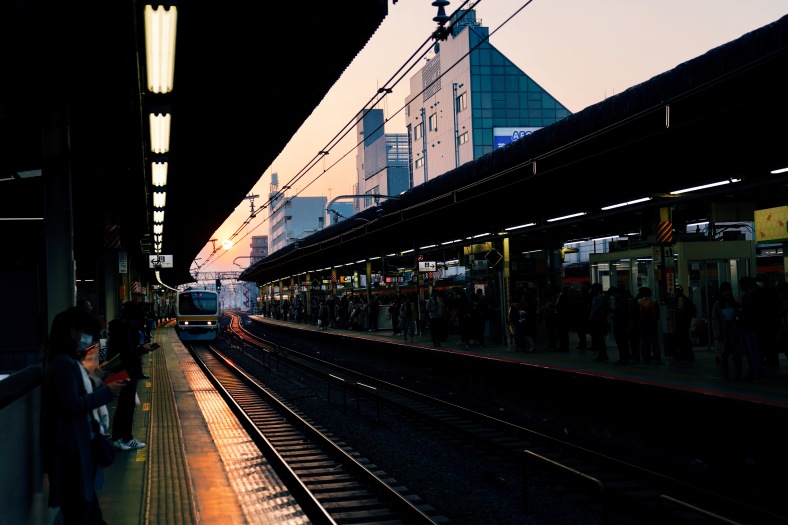
Sunset from Kichijōji station, Tokyo
I just got back from Japan, and need to keep myself awake for two more hours to avoid a painful jet-lagged week at work. Naturally, I figured that writing about my trip would be the most productive use of this time!
Japan is a fascinating and quirky place. You can easily spend months exploring the country and still be amazed at what you’ll discover. For this post though, I’ll focus on a 2-3 week itinerary and then note a few other places that we would have visited if we had more time.
Before I get into anything else though, you’ll need a Japan 101. So let’s dive right into it!
Best time to visit
Spring is usually the best time to visit Japan (late March – early April). Cherry blossoms are in full bloom and the weather is absolutely perfect. However, this is peak tourist season so everything gets booked up and flights can be expensive. Plan early if you’d like to visit during this time.
Hiking enthusiasts: Mt. Fuji is closed for hiking in April, so if that’s your goal, you should consider coming in the middle of the summer.
Money
Japan is a technologically advanced country in every possible way. Yet, they somehow don’t seem to like the idea of credit cards very much. Most places take cash only. This includes almost all subway ticket booths in almost all the cities we went to.
Japan isn’t opposed to all forms of plastic money though. Prepaid cash cards, known as “IC cards” are a very popular means of payment and are accepted at almost all train stations, and at most convenience stores. There are many different types of IC cards, and most of them are compatible with each other. The Suica card is popular in the Tokyo area, the Icoca card is popular in the Osaka area, and so on.
However, even prepaid cards don’t work everywhere. Japan has vending machines all over its cities, and most of them do NOT accept any prepaid cards (although this is changing fast). A lot of restaurants are cash-only and may or may not accept IC cards. Some Shinkansen trains (aka the Bullet trains) don’t accept IC cards, but some do.
As someone wanting to travel around Japan, this sounds fairly intimidating. So let me give you a tl;dr recommendation that will solve all your problems. Here are the 3 things you need to do:
- Take your credit card, and use it where you can.
- When you get to Japan, get a Suica Card or Icoca card from any train station (including the ones at the airport). Put a few hundred dollars on it. Use this if a credit card doesn’t work. You can also buy a Suica card online.
- Go to an ATM at the airport and withdraw about 200 dollars worth of yen (that’s about 20,000 yen). Use this if nothing else works.
You’re all set, financially.
Transportation
Japan has the most advanced, efficient, and punctual train network that I have ever seen in my life. Trains run at the accuracy of seconds. They always arrive on time, always leave on time, and transport more people every year than Earth’s entire human population. Trains and stations have tons of signage. Most cities have signs in English as well. The trains itself usually announce every stop in Japanese and English. If that wasn’t enough, they also have stuff like this which tells you exactly where you are in the train, and where the exits are at the upcoming station:

One can only wish for this in the NYC Subway
Incredible stuff. I was floored by the attention to detail here.
Needless to say, the most efficient way to get around the country is via train. The Japan Rail pass is a great way to get unlimited access to all trains run by Japan Rail. However, as we discovered, there are several other train companies in the country, each with its own set of trains that are not covered by the JR pass.
Just within Tokyo, there are at least three companies that own different trains within the city. When changing from one company’s train to another, you have to exit the ticket gate for company A, and then enter the gates for company B. One of the companies in Tokyo is Japan Rail, so all their trains are covered by the JR pass. The other two are not. To make things more confusing, each company has a different logo, so unlike London’s underground, where you have the same identifying signage for each subway station, you have to look for three different kinds of signs in Tokyo.
We stayed near Yoyogi Station in Tokyo. This station is serviced by a JR train line called the Yamanote Line, and also by a non-JR train line. The entrance for the former is referred to as the “JR Yoyogi” station, while the entrance for the latter is referred to as just “Yoyogi station”. Google Maps will give you the right directions, but won’t tell you which train transfers require you to exit and re-enter at a station.
Again, all this is really tough to wrap your head around as an aspiring traveler about to visit Japan for the first time. Here’s your tl;dr recommendation:
- Get a JR Pass. Make sure you order it 2-3 weeks before your trip, since they deliver the receipt to your non-Japan address. When you land in Japan, visit the JR counter at the airport with this receipt to get your actual pass.
- Use an IC card for all non-JR travel (most trains should work).
- Use cash for everything else, like a random bus or such.
You’re all set, transportationally. Yes, that’s a word.
Toilets
One of my favorite things in Japan. The toilet. Check out this typical toilet control panel from one of our AirBnBs:
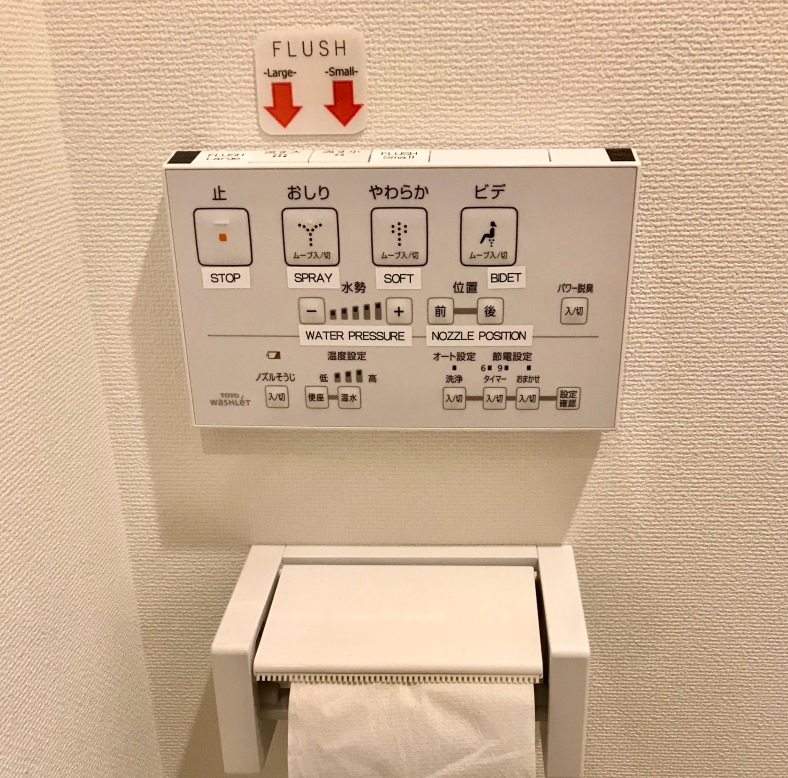
The most advanced toilet ever
Toilets in Japan have heated seats, they play music to drown out embarrassing bodily noises, they have spray and bidet functionalities to ensure that you leave with a sparkling clean bum, and the best part – public toilets are usually very clean. Unlike the US, I never saw a homeless person sleeping outside (or inside) a public toilet.
While I highly recommend trying out all the buttons when you get the chance to sit on one of these, I do have to point out one important thing: Most public toilets (and indeed half of our AirBnB toilets) DO NOT have any hand soap. This can become a real problem when you’re moving around and exploring a city. No wants to touch your dirty hands, and you probably don’t want to touch anything with said dirty hands either ;).
My recommendation:
- Pack a small hand sanitizer and carry it with you as you walk around town.
- Try the heated toilet seat. Relax, close your eyes, and enjoy that feeling.
You’re all set, hygienically.
Culture and language
Coming from the west, I was pleasantly surprised by how polite and helpful Japanese people are. Every time you walk into a restaurant, you’ll be greeted by the entire staff. If you’ve gone to a Japanese restaurant in New York City, this might seem familiar. When you leave a restaurant in Japan after eating, you’ll likely have someone bow you out, and thanking you for visiting.
Suits. You will notice A LOT of people in suits. You’ll see them everywhere (in bars, restaurants, paddle boating on a lake, you name it). The suits all look similar (dark, usually black), and I certainly sensed an undercurrent of uniformity and order when I looked at the people around me. There is actually a Wikipedia article on this.
Another thing you’ll notice is the high prevalence of cute cats, rabbits, and bright colored stuff. This is explained on the basis of a Japanese cultural phenomenon known as Kawaii. And yes, there is a Wikipedia article about that too.
A weird and fascinating place for sure!
It’s worth noting here that almost no one speaks good English. You might encounter an English speaking Japanese person here or there, but most of them won’t be able to communicate with you in English. However, we did not have any trouble getting around since almost every train station had signs and directions in English. Of course, this might not be guaranteed in all places, but Google Maps is always there to rescue you.
My recommendation for you:
- Get an international data plan for your phone, and turn it on for Google Maps so you can make your way around.
- Download the Google Translate app. Select the option to make this available offline. The app has an awesome feature where it lets you take a photo of a sign, and translates it. Very useful for reading menus.
- Learn some basic Japanese phrases on your flight over.
You’re all set, linguistically.
Food
Food – probably the #1 reason why most people visit Japan. Tokyo has more than twice the number of Michelin stars than any other city on the planet. The Japanese are perfectionists by nature, and when it comes to food, they leave no stone unturned to deliver the absolute best. Here’s a quick run-down of the kinds of food you need to try on your trip. Actual recommendations for restaurants are in my itinerary below.
- Sushi: The obvious thing you have to eat. I was a noob sushi eater until I went to Japan and had a 21-course Omakase style sushi dinner. It cost $200 per person (plus wine, which the sommelier paired with our meal courses), but it was one of the most incredible meal experiences of my life. Do it. You owe it to yourself.
- Yakitori: This is basically skewered, grilled meat. Absolutely delicious.
- Shabu Shabu: Japanese hot pot. I had this way too many times.
- Sukiyaki: Similar to Shabu Shabu, except that the meat is cooked skillet style.
- Pizza: Yes, pizza. Trust me – Japan knows how to make great pizza. I live in New York City, so this opinion means something.
- Strawberries: Holy shit. I have never had strawberries as incredible (and as expensive) as the ones in Japan. I ate about one box a day, and even considered paying someone to ship me strawberries from Japan on a regular basis.
- Whiskey: Japanese whiskey is the what the cool kids drink these days. For good reason! It’s delicious, and soul-soothing. Don’t believe me? Here’s what the experts are saying.
- Sake: Drink it with every meal. And then take a bottle home for a night cap.
You’re all set, gourmetically. I may or may not have made that word up.
CONGRATULATIONS ON COMPLETING JAPAN-101!!
Now that you know a little bit about Japan, let’s get into an actual itinerary. This is based on a 15 day trip that I just came back from, but I’ll include notes about places we would have visited if we had more time.

We definitely did not walk this
Of course, in this map, Google is assuming that you’ll walk the whole way. Please don’t. Or, go for it!
Tokyo (Days 1-6):
Tokyo is like New York City on steroids. Yes, it’s possible to have such a city. It’s easy to get overwhelmed by all the people and all the lights, so I’d recommend pacing yourself as you explore this great city.
Where to stay:
- We stayed near Yoyogi station, right between Shinjuku and Shibuya (both of which are full of tourists and crowded). The JR Yamanote train line (which runs in a circle around the middle of Tokyo) was right by us, and took us to most places we needed to go.
- Shinjuku is like the Times Square of Tokyo (with more character than the actual Times Square). It has lot of lights, lots of noise, and way too many people. I’d recommend not staying right there. Instead, stay close by in a quieter part of town. You’ll be spending a lot of time in Shinjuku but will likely not be able to sleep there.
- Ginza is a pretty cool (although slightly upscale) part of town with lots of nice bars and restaurants. If you’d like to try something different from a typical tourist, stay here. The Tsukiji fish market is located close by – wake up bright and early (4AM) and go watch a fresh fish auction.
Experiences:
- Shibuya crossing: Walk across the busiest intersection on the planet. Or, if you’re brave like us, walk across while dragging your suitcase.

This was oddly satisfying to watch
- Harajuku: This is like SoHo in New York City. Lots of main-stream shopping, but also lots of really quaint, boutiquey stores.
- Takeshita street: If you want to get a taste of the Kawaii culture I mentioned above, walk through this street in Harajuku. I’ve never seen such a cuteness overload in my life. Bunnies, Hello Kittys, and the color pink. Everywhere.

Bunnies, kitties, and pink
- Imperial Palace: Ah, to be an emperor and have an entire palace right in the middle of Tokyo. Life must be good over there. The grounds are perfect for an afternoon stroll in the spring. Cherry blossoms everywhere, waiting to be Instagrammed as shown here:

Like I said, highly Instagrammable
- Roppongi Hills: This was a cool part of town and is lovely to just walk around in. There’s a museum here called the Mori Art Museum, which was really nice. Couple of lovely bakeries in the same building where I ate way too much dessert.

I’ll let you figure out how we pulled this off (Mori Art Museum)
- Inokashira Park: This is a bit further out from downtown, but it was an absolute gem at sunset during cherry blossom season. We rented a boat, and hung out in the middle of the lake as the sun went down over the pink foliage all around us. Highly recommended.

Sunset and Sakuras
- Robot Restaurant: Oh boy. Where do I even start. This was the most insane and over-stimulating thing I have ever seen. You will either love it, or hate it. There’s no middle ground. Check it out and judge for yourself! Pro-tip: Take ear plugs with you. You’ll still be able to hear everything, but your ears will thank you later. Oh, and eat dinner before you go there. It’s not really a “restaurant”.
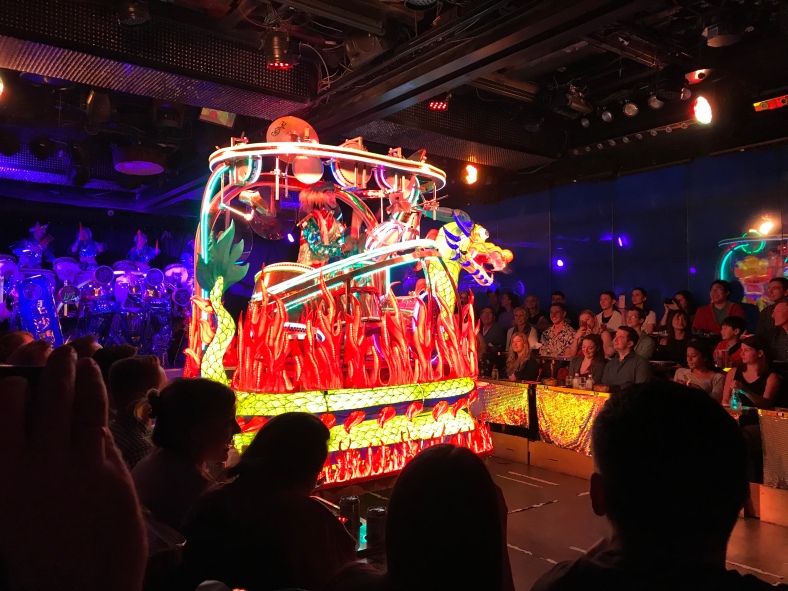
Robot Restaurant – absolute insanity
- Chureito Pagoda: One of the most iconic views of Mt. Fuji. This is a 2.5 hour journey, and requires a few train changes. The pain is definitely worth it! On our way to the pagoda, we stopped in Hachioji and ate some delicious ramen. Great day trip!

Mt. Fuji in the background
Bars:
- Golden Gai: This is a little area in Shinjuku that is full of tiny bars, each of which seats like 4-6 people. A little touristy, but we loved it! The drinks were great, and our bartender was super friendly. There is also a karaoke bar right as you walk towards GG – perfect spot to exercise your vocal cords after a few drinks.

Me attempting to sing “Castle on the hill”
- Zoetrope Whiskey Bar: This is hidden away inside some building in Shinjuku. It’s a little hard to find, and run by one guy. It has a 20s vibe, and several hundred types of whiskey. I’d recommend doing at least one tasting flight.
- Gen Yamamoto: Everyone you ask will recommend this place. It features a very skilled mixologist, and an incredible cocktail tasting menu. The one mistake we made was not reserving seats here. It gets booked up several weeks in advance to save your spots as early as possible.
Food:
- Sushi Tsu Roppongi: One of the most intense meal experiences of my life. A 21-course Omakase style 2.5 hour marathon. This will cost you over $200 per person (plus wine), and you will eat every sea animal possible. Highly recommended – just prepare yourself mentally before you go there. Reserve in advance.
- Nabezo Shinjuku Sanchome: This is a shabu shabu and sukiyaki place in Shinjuku. They serve two different kinds of broths in a container shaped like Yin-Yang. One of the broths is healthy, and the other is pure evil and absolutely delicious. Take your pick.
- Afuri Ramen: Hole in the wall kind of spot – you place your order via a vending machine of sorts. The ramen is delicious, and not too heavy.
- Bill’s brunch: There will be a day when you’ll crave a good ol’ western breakfast with eggs and bacon. When that day arrives, go here. The wait can be about 30-40 minutes though.
Hakone (Days 6-8):
After 5 days in Tokyo, you’ll probably want a couple of days of peace and quiet. Head over to Hakone to get just that! Hakone is a smaller town about 2 hours away from Tokyo by train.
The Hakone region is serviced by the Odakyu Railway Co. Your JR pass will not work on this, so I would recommend buying an Odakyu Railway pass that covers your entire stay in Hakone. This pass works on buses as well. You can buy it from Odawara station, which you will likely pass through on your way to Hakone (the Shinkansen from Tokyo stops here).
Where to stay:
- A lot of people prefer staying in Ryokans (traditional Japanese inns), but they get booked out months in advance, especially during peak tourist season.
- We stayed at K’s House hostel, about 20 min walk uphill from the main train station. The have a really nice patio with a nice view of the hills, and Japanese-style rooms.
Experiences:
- Onsen: The first thing you should do upon arriving in Hakone is to find the nearest Onsen (Japanese hot spring), and take a nice, long bath. Onsens are usually separated by gender and require you to take off all clothes. Don’t be shy.
If you stay at K’s House, they have an Onsen for guests. - Hakone Shrine: Everyone and their mothers visit this shrine when they come to Hakone. The shrine is cool, but one of most photographed spots is the Torii (gate) that stands in Lake Ashi. There will be a line of tourists waiting to take pictures here.

A very unique pose, in a very unique location
- Lake Ashi: After seeing the shrine, grab some pizza by the lake and take the boat to the other side. The lake is nestled within hills, and you might get a great view of Mt. Fuji from here on a clear day.
- Open-air museum: One of the must-do things in Hakone. We didn’t get to it because it rained the day we were planning to go there. But that doesn’t mean that you should miss it!
- Owakudani: You can get here by taking the rope-way up from Lake Ashi. This is a geologically active area so you might see fumes of Hydrogen Sulphide creeping up from the surface of the mountain.
- Climb Mt. Fuji: If you’re feeling adventurous and have a couple of days to spare, go hike Mt. Fuji. I wanted to do this, but April is not a good time to go up – the snow starts to melt around April, and the weather up there can be very cloudy and rainy. Best time to climb is somewhere in mid-summer. The hike takes a full day, and you usually stay in a hut near the summit to catch the sunrise. Number one item on the agenda for my next trip to Japan.
Food:
- Karuta: This is small, yakitori restaurant up in the hills of Hakone. It’s a 5-minute walk from K’s house. The food was absolutely delicious and we ate there twice.
- Kinosuke: Another yakitori place, right in downtown and close to the train station. The grilled chicken was amazing.
Kyoto (Days 8-11):
Kyoto is cool, hip, and very different from bigger cities like Tokyo and Osaka. For one thing, Kyoto is organized like a grid. It is also a bit more spread out, and the public transit situation is less amazing as compared to bigger Japanese cities.
One of the interesting things about Kyoto is that there is very little to do between 5PM to 7PM. Most things will close at 5, but that’s too early for dinner. I’d recommend waking up early, and visiting the shrines, markets and museums during the day. Take the 5-7PM down-time to rest and recharge before going out for dinner and drinks.
Where to stay:
- You’ll notice that most of the things you’ll want to see as a tourist are located a bit outside the main city. A lot of these shrines and temples also happen to be fairly far from each other. As such, I’d recommend staying somewhere in the middle and spending an entire day on each side of the city.
- We stayed right by the Karasuma Oike station and found that to be fairly central relative to the places we wanted to visit.
Experiences:
- Kiyamachi Street: This is lovely street that runs north-south right by the river. It is lined with Sakura trees and is an absolute treat during cherry blossom season.

Sakura trees in full bloom
- Arashiyama Bamboo Grove: Generally speaking, Kyoto gets a lot of tourists and you’ll find most places to be packed by 10AM. I would recommend waking up early and experiencing things before everyone else does. Arashiyama is a bamboo grove towards the north-west of Kyoto. It’s very Instagrammable when empty, except that you’ll never find it empty unless you wake up at 5AM. So do that.
- Otagi Nenbutsu-ji: If you walk a bit north of Arashiyama, you’ll end up walking up this really pretty street with a bunch of cute stores and temples along the way. Here’s me outside one of them:

Channeling my inner MJ (Nison-In Temple)
If you go all the way up, you’ll get to Otagi Nenbutsu-ji temple, which is a buddhist temple built in the 8th century. Fair warning though, this is pretty out of the way and you’ll have to wait up to an hour for the bus. If you’re tight on time, I would recommend not going all the way up to this temple.
- Kinkaku-ji: This is the most famous Zen Buddhist temple in Kyoto. You might have seen it in photos – it’s a big golden colored structure with a lake. This is located towards the north of Kyoto and will take about 30-40 minutes to get to from Karasume Oike.
- Nishiki Market: One of Kyoto’s most famous markets. Great to walk around in the early evening. It has one of the most famous kitchen knife stores in Japan (Aritsugu knives), and lots of little shops and restaurants.
- Fushimi Inari-Taisha: Kyoto’s most famous Shinto shrine. Located diametrically opposite to Arashiyama, so I would recommend not trying to do both in one day. This place is absolutely amazing, but crawling with people. I woke up at 6AM and ran to it. Once there, use the opportunity to walk through the hundreds of Torii gates that line the trail, which goes all the way up and down the hill. It is an amazing, and incredible experience. Try going all the way up to the summit – the higher you go, the fewer people you’ll encounter.
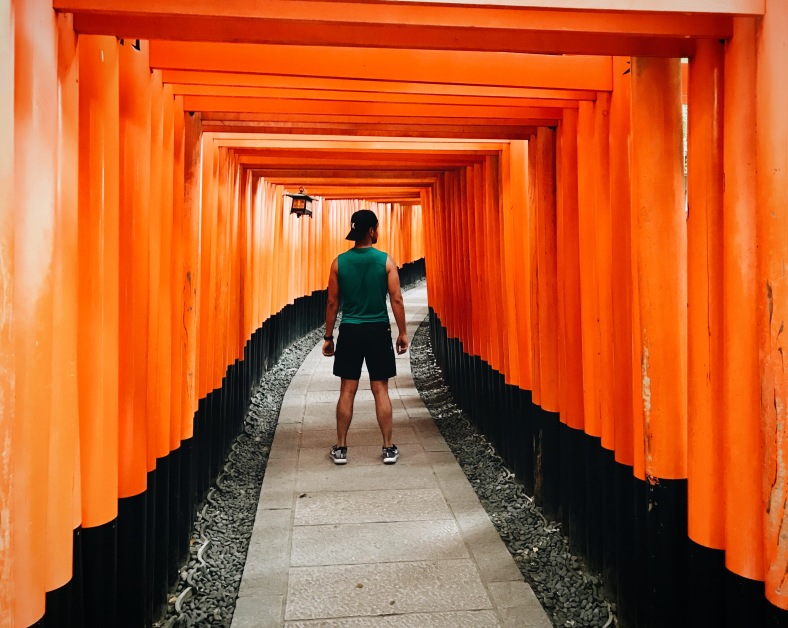
Worth the early wake-up
- Gekkiekan Okura Sake Museum: This is located all the way to the south of Kyoto. It’s not very big, but provides a great view into how sake is made. They also do sake tastings and sell sake for you to take back home.
Food:
- Pontocho Alley: This is a little alley that runs parallel to Kiyamachi street. It is lined with several great restaurants and bars. I would recommend coming here for dinner every day. Walk into any restaurant, get a seat facing the river, and enjoy a fantastic dinner while looking at the view.

Pontocho Alley

Sukiyaki dinner, somewhere in Pontocho
- Kushikura: This is a yakitori place that was recommended to us by someone who owns another restaurant in Kyoto. It was probably one of the most delicious yakitori I’ve had. We were lucky to be able to walk in, but I’d recommend reserving spots.
- Sentido: This was a cute little coffee shop where we ate breakfast every day. Great vibe, and nice sandwiches.
Bars:
- Hello Dolly: This is a bar located in Pontocho. Plays jazz music and serves delicious cocktails. Highly recommended.
Nara (Days 11-12):
Nara used to be the capital of Japan in the 8th century. You can visit either as a day trip from Kyoto or Osaka, or (as we did), go from Kyoto to Osaka via Nara while staying there for a night.
Where to stay:
- Nara isn’t very big so anywhere close to the park is fine. You’ll be able to walk to most places from there.
Experiences:
- Nara Deer Park: Deer roam freely in this park. You can buy deer food and feed them! Just remember – they are still wild animals and you should exercise caution while feeding them. Deer are said to bow if you bow to them – give it a shot and tell me if that worked for you ;).

Not pictured: Us feeding a deer
- Sanjo Dori: This is sort of the main street to walk along, with most restaurants located around it. If you get lucky (like we did), you might get to see the mochi making process live. It is an incredible thing to watch.
Food:
- Cafe Wakakusa: Lovely little cafe that serves crepes. They also have a cute dog that we played with. Perfect place to have breakfast.
- Mellow Cafe: Great vibe, decent food. Serves a bunch of different kinds of cuisines – Italian, Indian, American.
Osaka (Days 12-15):
Osaka is like the Chicago of Japan. Second largest city, edgier than Tokyo, fewer tourists, lots of interesting things to do. It is also a good base to do a bunch of day trips to other parts of southern Honshu.
Where to stay:
- We stayed near the Dotonbori river (just north of it), which is close to the major shopping and food districts. The area is very walkable and has lots of bars and restaurants.
- The public transit system in Osaka is decent enough to get you to the places you’ll want to go so it won’t be a major issue if you stay elsewhere.
Experiences:
- Osaka Aquarium: The have two whalesharks, a hammerhead shark, and a lot more. Definitely worth a visit!
- Dotonbori District: This is like Osaka’s Times Square. Lights, tourists, theater, giant crab mounted outside a building with moving legs.
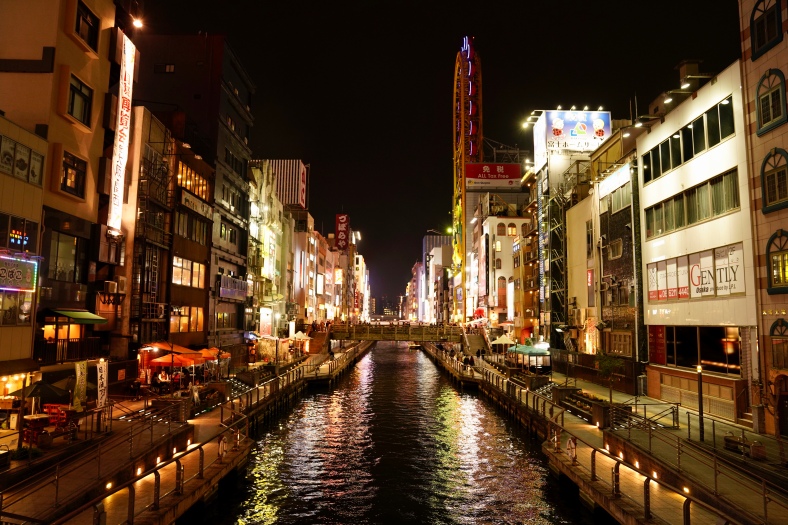
Dotonbori River
- Orange Street: Quaint and interesting street with lots of boutiquey stores and a few cat cafes. I would recommend going to one and feeding the cats – it’s quite the experience.
- Osaka Castle and Museum: This is an impressive museum – it is about 8 stories high with a long line for the elevator. Skip the line and take the stairs to get there right away. The view from the top is great. As you make your way down, learn about the history of Osaka and the castle via some really cool 3D holograms. The castle’s grounds are lovely to walk through.
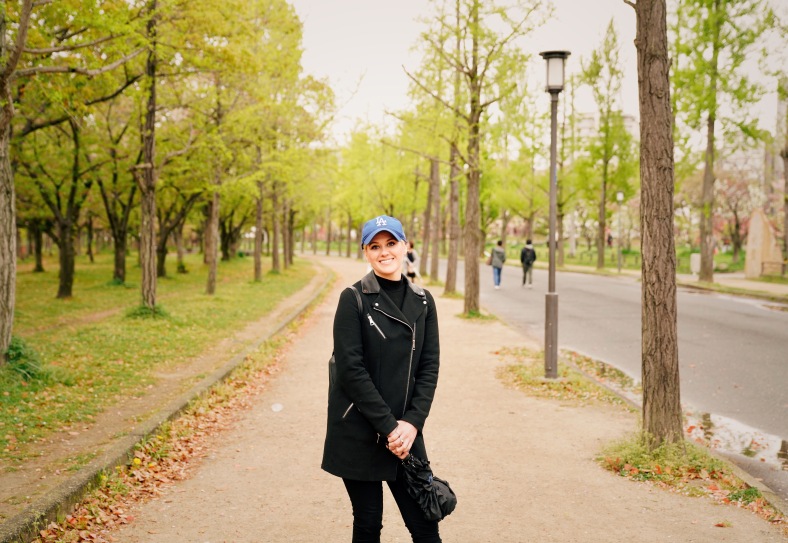
Osaka Castle grounds
- Nakanoshima Park: Walkable from the castle, this is a park located on an island. We found it a bit underwhelming, but that was probably because it was a cloudy day when we decided to go there.
- Ror Comedy Club: An underground comedy club that is clearly targeted towards westerners. Nevertheless, the acts were great and we went out with a couple of comics after the show.
- Shinsaibashi shopping district: Spend and afternoon walking around – lots of interesting stores, along with the usual mainstream stuff. We went here on our last day to do some shopping.
- Day trip to Hiroshima: This is something we wanted to do, but couldn’t because of a massive hangover following a night out with the comics from Ror comedy. It takes about 2.5 hours to get to Hiroshima via the Shinkansen train from Osaka. If you make it out there, check out the Peace Memorial that serves as a reminder of the destruction that can happen when a nuclear bomb is dropped on a city full of people.
Food:
- Barbacoa Churrascaria: Brazilian barbecue. They keep bringing meat to your table until you tell them to stop. See if you can last more than 30 minutes.
- Good Spoon: Fantastic place to get brunch. Even better when you’re hungover.
- Don Shop Shabutei Mitsuderasuji: Shabu shabu restaurant, where we ate our last meal in Japan. It was thoroughly satisfying.
Bars:
- L&L Bar: Same venue as Ror comedy. Drinks are average, but vibe is great. Also, the comedy club is right there.
- Farplane: Women’s clothing store on the outside, interesting bar with a gigantic penis inside.
Closing thoughts
This has been a long post with a lot of information. I wrote it in a way that would answer all questions that a first-time traveler to Japan might have. I hope this helps and I would love to hear about your travels in this wonderful country!

Tokyo Tower

Reblogged this on Random Repeat.
LikeLiked by 1 person
I want the japan visit.
LikeLike
Thanks for your SUPER USEFUL Information. In Osaka, did you go to Universal Studios?
LikeLike
I did not! There is so much to do in Osaka, and we only had a few days to squeeze it all in :).
LikeLike
Can you share the budget, as this important while planning a trip
LikeLike
thank u so much for the information.
LikeLike
For this Itinerary, how may days of JR pass did you book?
LikeLike